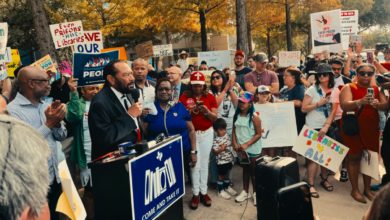Busing to desegregate the city of Birmingham Ala., a focal point of many hard-fought struggles in the civil rights movement of the 1950s and 60s, is now the center of a court battle.
In 1970, a federal court ordered the city of Birmingham to implement a busing plan to desegregate its schools. Black
|
In a racist attempt to avoid sending its children to Black-majority schools in Birmingham, Vestavia Hills established its own school system. However, at the time, a federal judge ruled that the 99 percent-white school system had to accept children from a designated portion of neighboring Oxmoor Valley, a working-class, African American neighborhood nearby.
Vestavia Hills is now requesting that a federal judge grant it “unitary status.” It wants the judge to give it the authority to act as its own regulator, thereby freeing it from court supervision and court obligations to desegregate. (Los Angeles Times, Oct. 6)
Vestavia Hills officials argue that the issue is one of overcrowding. Jamie Blair, superintendent of Vestavia Hills schools, told the LA Times that, in the last four years, the number of Oxmoor students in the district has risen from 75 to 132. “Simply put, it’s an overcrowding issue,” Blair stated.
But Theodore Lawson, an attorney who lives in Oxmoor valley, countered: “The only effort to relieve overcrowding has been to remove 132 black students from the school system.”
The request is specifically states that Vestavia Hills would continue educating the 132 Black students currently in their school, Oxmoor High, as well as their siblings, but that all other Black students would attend Birmingham schools.
Vestavia Hills is one of the most exclusively white areas of Jefferson County, the county in which Birmingham is located. According to the 2000 census, Vestavia Hills is 94 percent white and has a median income of $70,000.
Birmingham, in stark contrast, has only a 24 percent white population and a median income of $26,000. The majority of the city’s population is Black. Only 5 percent of the students in Birmingham schools are white.
Background to school desegregation orders
Following the overthrow of progressive post Civil War Reconstruction governments (1865-1877) in the southern states, the aspirations of Black people for equality suffered a century-long reversal.
Apartheid and police state rule existed in all the former states of the Confederacy. Vicious racism and enforced segregation were dominant in the northern states as well. During this century of extreme racism, the Supreme Court and most lower courts provided one legal sanction after another for enforced segregation.
It was only the specter of a potential rebellion as evidenced by the beginnings of civil rights organizing in the early 1950s, that pushed the Supreme Court to rule that “separate is not equal” and order desegregation of schools in Topeka, Kansas. That decision was embodied in the 1954 Brown v. Board of Education decision.
Brown v. Board of Education was a step forward at the time. It gave the growing civil rights movement a legal decision to use for further mobilization. Legislation passed a decade later—the Civil Rights Act of 1964 and the Voting Rights Act of 1965—further extended the legal rights of African Americans.
Throughout the 1970s, U.S. courts enjoined school districts to desegregate by busing children to segregated schools
These efforts were the focus of constant racist assaults. In 1986, Riddick v. School Board of the City of Norfolk, Virginia became the first federal court decision to permit a school district to dismantle its desegregation plan.
The court opinion said that even though the school board’s decision to end elementary school busing might have a deleterious effect on Black students in Norfolk, if the intent to discriminate by the district could not be proven, there was no constitutional violation.
The court said, “This purpose, or intent to discriminate marks the difference between de facto and de jure segregation”—the former being legal, the latter illegal. This decision meant that if ending busing results in racist segregation, it was ok as long as the school board did not intend this result. This false distinction between intention and actual results provided legal cover for the capitalist state’s racist moves.
Six months after the decision came down, the cross-town busing of elementary school children ended in Norfolk.
On January 15, 1991, the U.S. Supreme Court ruled in Board of Education v. Dowell that formerly segregated school districts “may be released from court-ordered busing once they have taken all ‘practicable’ steps to eliminate the legacy of segregation.”
The 5-to-3 decision said the likely re-emergence of segregated schools as a result of local housing patterns was not necessarily a bar to lifting a busing order, as long as the housing patterns were a result of private choices and were not themselves “vestiges” of the era of official segregation. (New York Times, Jan. 15, 1991)
In the 15 years since Dowell, courts have lifted desegregation orders in more than 100 school districts, from Alabama to California. The courts have sided with school districts requesting the dismantling of busing in almost every instance.
This year alone, federal courts have sided with districts seeking to overturn desegregation orders 36 times.







